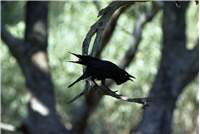Family
Corvidae
Genus
Corvus
Species
coronoides
Threats/Control Methods - Regional
This species can represent a health risk by contamination from their droppings in urban eating areas. Shooting is a control method in some agricultural regions. Noise emitting devices may also be effective in the short term.
Threats/Control Methods - Local
This species may spread disease if it congregates in large numbers in busy urban environments. Currently no control methods are being carried out in the ACT.
Local/Urban Actions
The increasing number of Ravens in the suburbs is due to the abundance of food and water. Residents can limit this availability by carefully securing all garbage and food scraps and by avoiding any unnecessary irrigation of lawns and gardens. It is also helpful to cover compost heaps and removed any fruit falling to the ground around fruit trees.
Common Names
Australian Raven, Crow, Kelly, Raven
Distinguishing Features
Australian Ravens are black with white eyes in adults. The feathers on the throat (hackles) are longer than in other species, and a bird tends to extend these when calling. They are fairly large, at 52cm in size. The young are similar, with darker eyes of first blue-grey and then brown.
Survey Techniques
Calls and behaviour offer the best identification for this species.
Species Call
A slow territorial, rather high "ah-ah-ah-aaaah". It also gives high wailings.
Similar Species
Across Australia, different species of Ravens and Crows like very similar. The Little Raven (Corvus mellori ) is easily mistaken for the Australian Raven and calls are the best way to distinguish the species. In Canberra, the Australian Raven is the most likely to be seen.
Distribution
The Australian Raven is found in eastern, southern and central Australia.
Country of Origin
Australia
Conservation (Pet/Pest) Status - Regional
There has been a steady increase in numbers from 1985 (COG).
Conservation (Pet/Pest) Status - National
Secure, not listed under the EPBC Act 1999. They are considered a pest in many agricultural regions and also in cities where they make noise and damage window fittings and cars.
LSCCES Population
The Australian Raven was found in high numbers right across the Lower Sullivans Creek Catchment.
Associated vegetation community
The Australian Raven is found in all habitat types, excluding the arid deserts of WA and preferring open country, both natural and cleared.
Limiting Resources
The species depends upon readily available waste products for scavenging, easily found in the city or alongside roads with fast moving traffic. It also depends upon high trees for roosting.
Breeding
Ravens will breed from when they are three years of age. The breeding cycle for Australian Ravens is lengthy, taking from 20-30 weeks. Nest building usually begins in July and young are dependant until January. Their untidy nests are made of sticks, grasses, bark and feathers and constructed very high on a steep vertical tree fork. 4-5 large eggs a laid, each with a pale blue and brown spotted appearance. Both parents share the incubating and feeding responsibilities.
Behaviour
The species is usually seen in pairs; however flocks of up to 40 birds can be seen scavenging through the rubbish at Canberra's Mugga Lane tip.
Functional Group
Food Species
The species is mainly carnivorous; although it also scavenges around grocery stores and waste disposal areas both in the city and at landfill sites. The diet of suburban birds includes meat, insects, fruit and bread. Rural birds usually depend on road kills or grains from nearby farms.
Predators
Due to the strong body of this species, it is not in threat of predation and will instead feed on the young and eggs of other bird species.
Interesting Fact
The Australian Raven is the largest of the Corvidae family. The long, prominent feathers on its throat or neck make it easy to identify.
References - (reader suitability of references, P=Primary teachers, S=Secondary students, T=Tertiary students and researchers)
Books:Morcombe, M. 2000. Field Guide to Australian Birds. Steve Parish Publishing. Archerfield. Australia P, S, T
Schodde, R. and Tideman, S. (eds) 1990. Reader's Digest Complete Book of Australian Birds (2nd Edition). Reader's Digest Services Pty Ltd. Sydney. P, S, T
Veerman, P. 2003. Canberra Birds: A report on the first 21 years of the garden bird survey. Philip Veerman and Canberra Ornithologists Group. Canberra. S, T
Internet: Birds in Backyards. 2006. [online]. Available at:http://www.birdsinbackyards.net P, S, T
Canberra Ornithological Group (COG). 2004. Birds of Canberra Gardens. COG and the ACT Department of Urban Services. [online]. Available at:http://garden.canberrabirds.org.au/ P, S, T
Online Publications: Department of Environment and Conservation. 2006. Prevention and Control of Damage by Animals in WA: Raven Corvus coronoides. Department of Environment and Conservation. Western Australia. [online]. Available at: http://www.naturebase.net/component/option,com_docman/task,doc_details/gid,274/P, S, T
Nix, H. and Cunningham, R. 2006. Birds of the Lower Sullivans Creek Catchment, Canberra ACT. Prepared for the Life in the Suburbs project using data from the Lower Sullivans Creek Catchment Ecological Survey (LSCCES). Australian National University. Canberra. [online]. Available at: http://www.lifeinthesuburbs.com.au/category.php?id=65 S, T


 Top
Top Top
Top